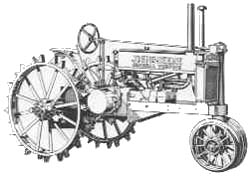 How wide is a row? 42 inches. Why? That's the average width of a horse. Historically, row width was determined by how close the horse could be driven to the previous row. Early multi-row equipment adopted the 42-inch standard. Early tractors, built to pull that equipment, froze that standard into steel with drop housings and fixed tread. How wide is a row? 42 inches. Why? That's the average width of a horse. Historically, row width was determined by how close the horse could be driven to the previous row. Early multi-row equipment adopted the 42-inch standard. Early tractors, built to pull that equipment, froze that standard into steel with drop housings and fixed tread.
But problems arose: a fixed tread imposed limitations on farmers beyond certain specific row spacings. It limited the attaching points available to equipment designers. Plows, which worked to the right of tractors, developed side draft.In 1934, John Deere introduced the Model "A" (above) with answers to all these problems. Two industry firsts, adjustable wheel tread and a one-piece transmission case providing high under-axle clearance, solved the first two problems. And the implement hitch, as well as the powershift, was located on the centerline of the tractor, effectively reducing side draft.
Other improvements on the "A" included: Power lift converted from a mechanical to a hydraulic system, increasing both efficiency and speed of operation. It also provided a "cushioned" drop of equipment.
Differential brakes geared directly to the large drive gears, increasing mechanical efficiency and easing operation.
Farmers welcomed the "A" and its variations so strongly that it became the most popular tractor in the company's history.
The original "A" was rated at 16.22 drawbar hp and 23.52 belt-pulley hp.
Production Year & Serial Number |

